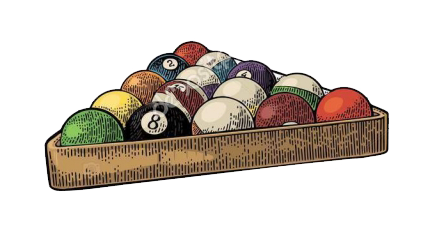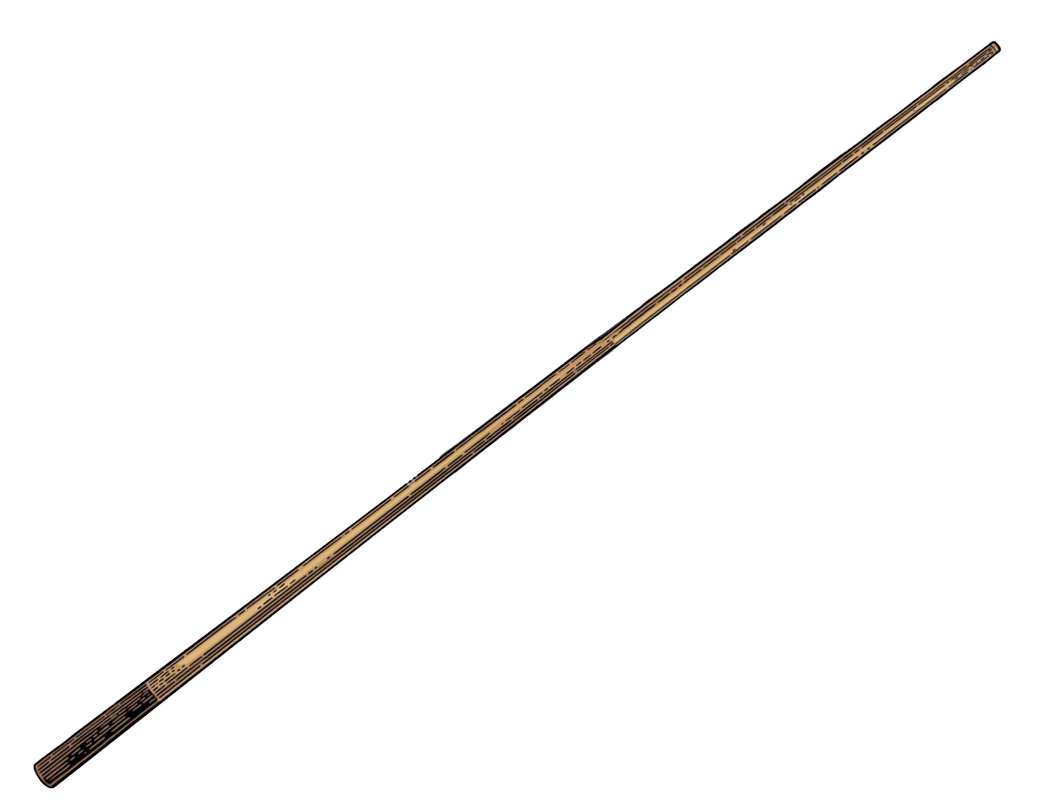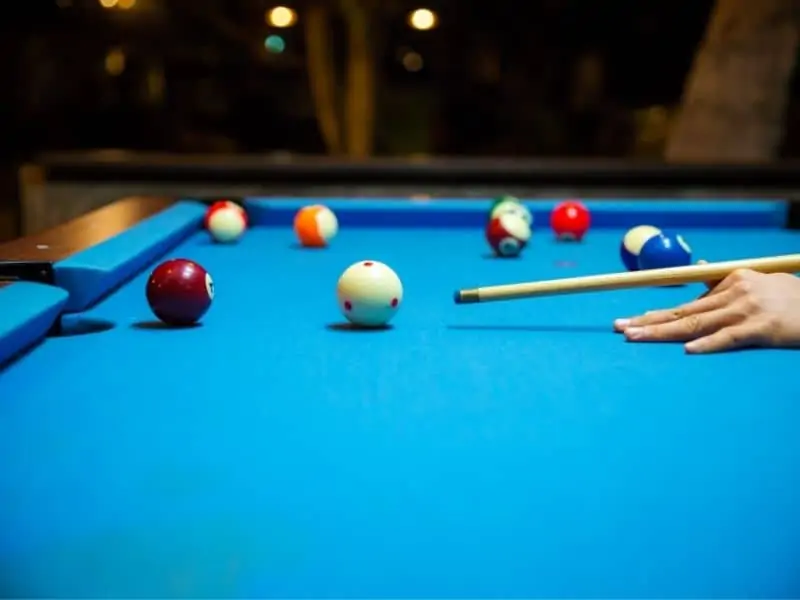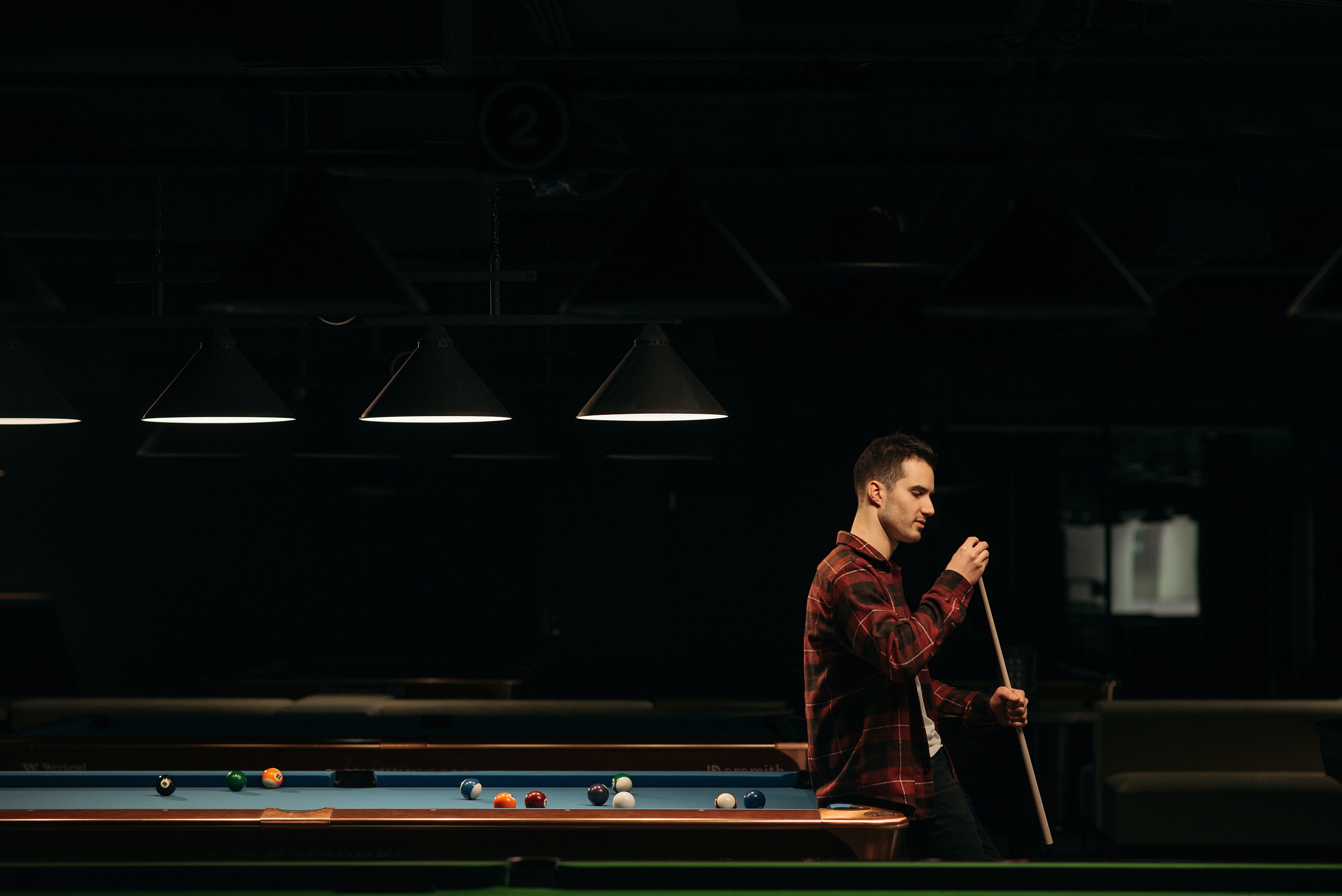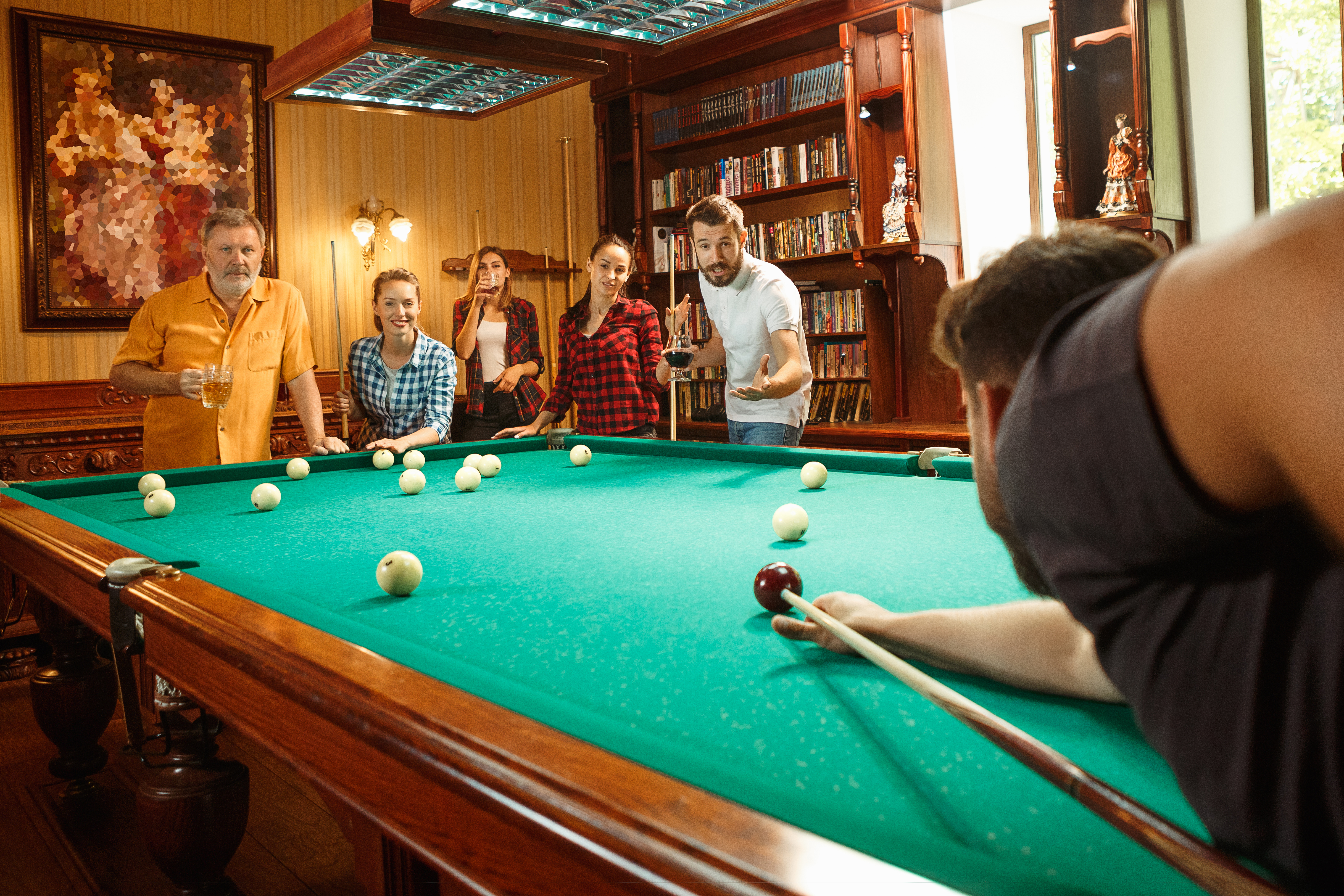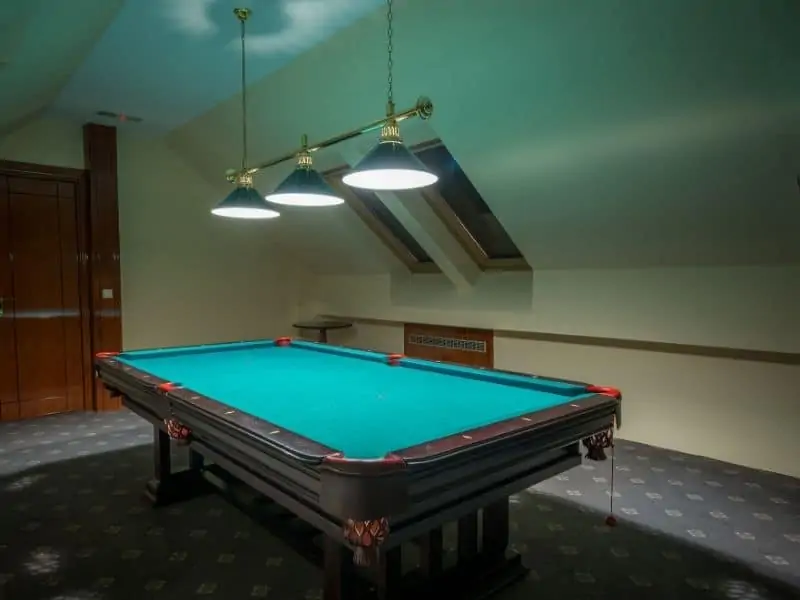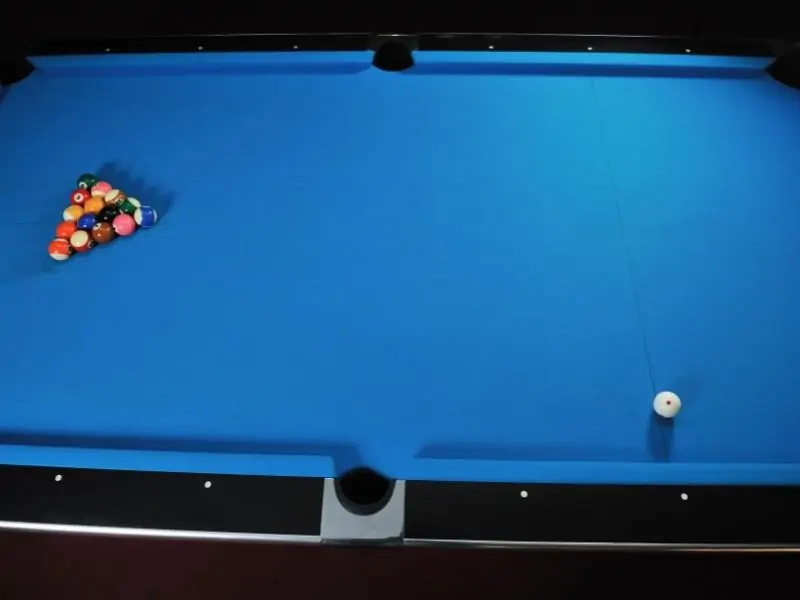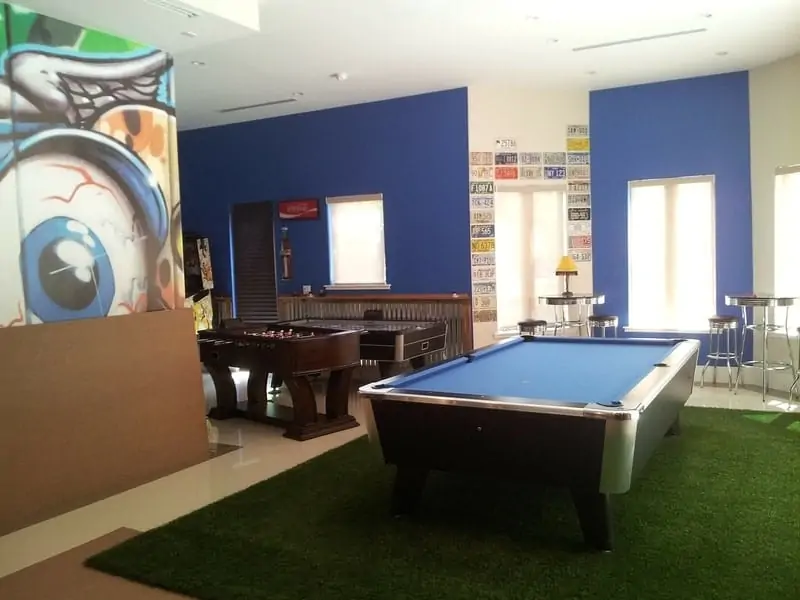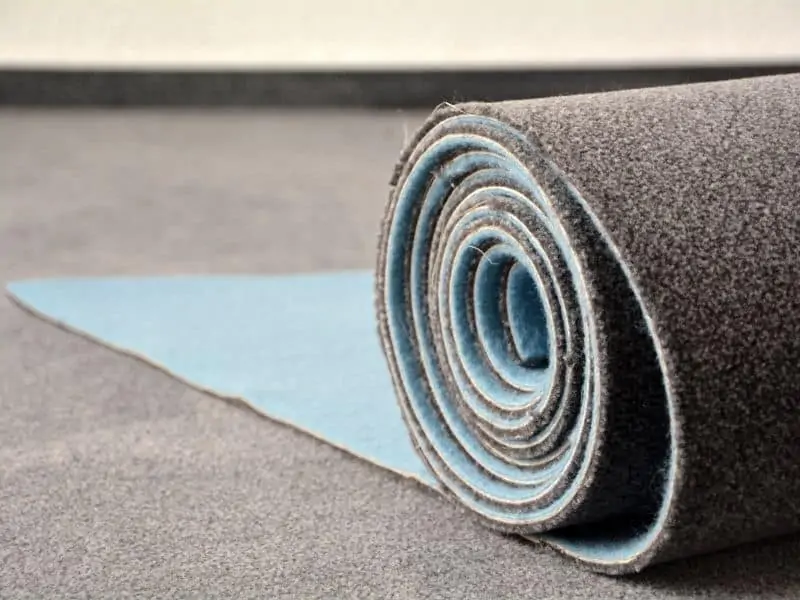If you’ve never played bank pool, you’re missing out!
Bank pool, as its name implies, is a pool game that requires every pocketed ball to be banked off a cushion into a called pocket. Not only is this game a blast to play, it will seriously challenge you as well, especially if you haven’t practiced bank shots much.
So, whether you’re new to the game of pool, or just looking for a new game to try, bank pool is a great game to learn and play. In this article we’re going to discuss how to play bank pool, the rules of bank pool, and everything else you need to know before racking your first game. Enjoy!
Bank Pool 101
Bank pool is typically played with 15 object balls and, of course, the cue ball. The object of the game is to legally pocket more object balls than your opponent via bank shots. If you’re playing with a full rack (15 object balls), then the first player to legally pocket 8 object balls wins.
A shorter version of bank pool can be played if desired. Instead of racking all 15 object balls, simply rack like you would a game of 9-Ball instead. In this case, the first person to legally pocket 5 out of 9 balls would win.
All scoring is done via bank shots only and every shot has to be called.
Racking a Game of Bank Pool
Depending on how many object balls you’re using, bank pool is racked with either a triangle rack or a diamond rack. All object balls are placed in random order within the rack. There is no special formation or orientation used for bank pool. Just throw em’ in there!
The rack is then placed at the foot spot of the table, just like you would for any other pool game. The cue ball has to be placed behind the head string of the table.
With the rack in place you then proceed to the break. Who gets to break is typically decided by flipping a coin, rock-paper-scissors, or any other method you prefer.
On the break shot, and when playing with a full rack, a minimum of 2 object balls must come in contact with the rails or else it is considered an illegal break.
When playing with 9 object balls, the head ball must be contacted first on the break and at least one object ball must come past the side pockets. Failure to do so is an illegal break as well.
In the event of an illegal break, the opponent may request a re-rack or accept the table as is and begin shooting.
If you pocket a ball on the break, you continue shooting. However, any ball pocketed on the break does not count toward your score and has to be spotted after your inning ends. We’ll discuss where the balls have to be spotted a little later.
After the Break
After the break, the shooting player will then proceed to legally pocket any object ball in any order until he either misses a shot, scratches, or fouls. All object balls are legal. If you fail to legally pocket an object ball, your turn ends.
Bank pool is a call shot game. This means that any ball you pocket, has to be called in advance. You must make clear which ball you intend to hit, which rail(s) it will hit, and which pocket it will enter. If you make the shot, but not in the way in which you called it, the shot doesn’t count and will be spotted without penalty to the shooter.
Each players inning will continue for as long as they continue to pocket shots legally. You can only pocket one ball per shot. In the event that you pocket multiple balls, the ball that was pocketed unintentionally will be spotted at the end of your inning.
Pocketing a second ball does not result in the end of your inning. Your inning ends if you fail to legally pocket an object ball, scratch, jump the cue ball off the table, or if you foul.
Any ball that is pocketed without being banked and called is illegal.
That means no kick shots, no combination shots, no kiss shots and no carom shots.
A ball is only legally pocketed if:
- It’s pocketed as a result of a bank shot only.
- Its properly called.
- Its not contacted by the cue ball more than once.
Fouls To Be Aware Of
Bank pool has some fouls that you need to be aware of. Any scratch or foul means your inning is over and you owe one ball to the table.
If you foul and owe a ball back to the table, this means you have to spot one of your previously pocketed balls. If you foul with no balls already pocketed, you will then have to spot your first legally pocketed ball after the inning is over in which it was pocketed.
If you pocket a ball and scratch/foul on the same stroke, the pocketed ball is forfeited and you still owe one ball to the table. You will owe one ball to the table for each scratch/foul you commit.
It is also considered a foul to jump the cue ball off the table. It is not a foul, however, to jump an object ball off the table. The object ball simply has to be spotted at the end of the shooters inning.
Anytime the cue ball is scratched or jumped off the table, it is then given to the opponent who then has ball in hand behind the head string. After any other foul, however, the opponent has to shoot from where the cue ball is currently.
If you foul during three successive turns, you lose the game. However, more advanced players may agree that three non-successive fouls result in a loss. This can be decided beforehand between you and your opponent.
Where to Spot Illegally Pocketed Balls
Ok, so you’ve illegally pocketed a ball or jumped it off the table. Now where are you supposed to spot it at?
Any ball that needs to be spotted must be placed at the foot spot of the table. If there is a ball already in the foot spot position, or multiple balls need to be spotted, they must be spotted in a direct line below the foot spot toward the foot of the table.
If you’re unfamiliar with the foot spot of the pool table, here’s a handy diagram I found on Pooldawg.com. This diagram helps illustrate the different spots on a pool table perfectly.
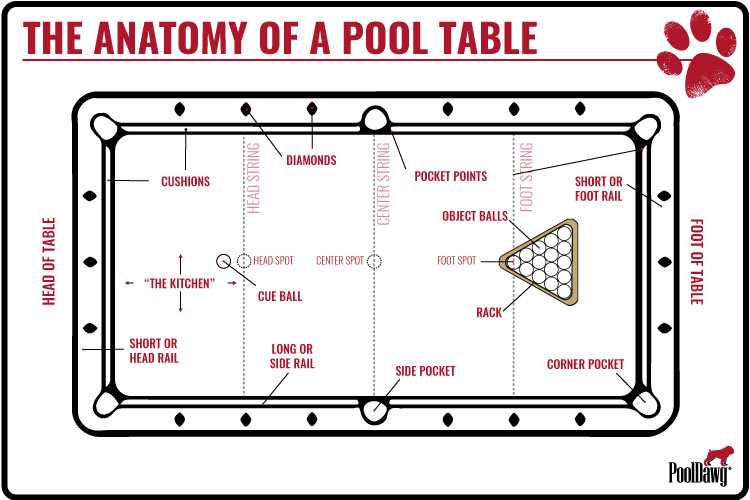
Spotted balls have to be frozen to any other object balls that interfere. The cue ball is the only exception.
Any ball(s) that need to be spotted have to be done at the end of the current shooters inning. That is, unless, there are no more object balls on the table. In this case, any balls needing to be spotted have to be spotted immediately.
Safety Shots
Safety shots are allowed in bank pool. After the cue ball has made contact with your called object ball, at least one object ball must be pocketed, or the cue ball or another object ball must make contact with at least one cushion for the shot to be legal.
There is no penalty for pocketing an additional object ball during a safety shot, meaning you wont owe the table a ball. However, doing so will result in the end of your turn.
Winning the Game
The game of bank pool is won when one player has legally pocketed the predetermined amount of object balls and doesn’t owe any balls to the table.
Advanced Tips and Strategies for Bank Pool Mastery
Once you’ve got the basics of bank pool under your belt, it’s time to delve into some advanced tips and strategies that can elevate your game to the next level. Understanding these will not only give you an edge over your opponent but also deepen your appreciation for the complexities that bank pool offers.
Angle Is Everything
The angle at which the cue ball hits the object ball and the cushion significantly impacts the direction in which the object ball will travel. Utilize geometry to calculate the most optimal angle for your bank shots. Practicing at different angles will give you a robust set of skills to pull from during matches.
Know Your Table
Understanding the quirks of the pool table you’re playing on can be a game-changer. Some tables may have cushions that are more or less responsive, affecting the angle of the bank. It’s advisable to take a few practice shots to get the feel of the table before starting a serious game.
Speed Control
The speed at which you strike the cue ball can alter the outcome of a bank shot. A faster speed generally means a more extended bounce-off from the cushion, while a slower speed might shorten the angle. Mastering speed control can help you make more challenging bank shots.
The Double Bank Shot
For those who have developed a keen sense of angles and speed, the double bank shot can be a powerful tool in your arsenal. This involves banking the object ball off one cushion and then another before it finally goes into a pocket. While difficult to execute, it can be an impressive and tactical move.
Safety Plays
In advanced bank pool, the safety game becomes crucial. If you find yourself in a position where making a bank shot is unlikely, consider a safety play to put your opponent in a tough spot. Remember, the key to a good safety is to leave the cue ball in a position where your opponent has limited options for easy bank shots.
Cue Ball Spin
Applying spin to the cue ball can make your bank shots more precise and challenging for your opponent to read. Side spins, or “English,” can be especially helpful for manipulating the object ball’s path after it hits the cushion. Experiment with different spins to understand their effects on your shots.
Practice, Practice, Practice
As with any sport, the key to mastering bank pool is consistent practice. Take time to hone your skills, focusing on weak areas and mastering a range of shots. The more diverse your skill set, the more unpredictable and formidable you become as a player.
In Conclusion
Bank pool may sound a bit confusing on the surface, but once you play it a few times its just as simple as any other billiard game.
All in all, bank pool is a great way to improve your bank shot skills and is super fun to play. I hope this article has been helpful and that you’ll check out our other super helpful articles for all of your billiard related questions.
Other Articles You May Be Interested In:
Best Pool Cues for the Money: Discover the top pool cues that offer great value without breaking the bank.
Pool Table in the Garage? Here’s What You Need to Know: Understand the essential considerations for setting up a pool table in your garage.
Break Cue vs Playing Cue: What’s the Difference?: Learn the key differences between break cues and playing cues to enhance your game.
How Much Does a Good Pool Cue Cost?: Explore the factors that determine the cost of a high-quality pool cue.
Are Mini Pool Tables Worth It? A Complete Guide: Read our comprehensive guide on mini pool tables and decide if they’re the right fit for you.
